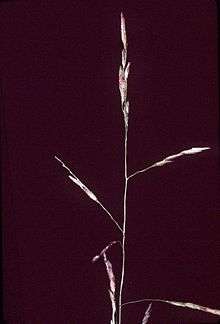Leersia virginica
| Leersia virginica | |
|---|---|
 | |
| Scientific classification | |
| Kingdom: | Plantae |
| Clade: | Angiosperms |
| Clade: | Monocots |
| Clade: | Commelinids |
| Order: | Poales |
| Family: | Poaceae |
| Genus: | Leersia |
| Species: | L. virginica |
| Binomial name | |
| Leersia virginica Willd. | |
Leersia virginica, commonly known as whitegrass, white cutgrass, or Virginian cutgrass, is a perennial grass that is native to eastern North America, typically found in partially shaded low-lying wet areas.
Its blooming period occurs from mid-summer to early fall. Whitegrass can be distinguished from rice cutgrass (Leersia oryzoides) by its smoother leaf sheaths, flowering heads with solitary lower branches in the flowering heads, smaller and more strongly overlapping spikelets, and short rhizomes with overlapping scales. Rice cutgrass, in contrast, has leaf sheaths round enough to cause painful scratches, flowering heads with two or more branches at the lowermost nodes, larger and barely overlapping spikelets, and more elongated rhizomes with the scales usually not overlapping. [1]
References
External links
![]() Media related to Leersia virginica at Wikimedia Commons
Media related to Leersia virginica at Wikimedia Commons
 Data related to Leersia virginica at Wikispecies
Data related to Leersia virginica at Wikispecies- USDA Plants Profile
- Iowa State University Department of Ecology, Evolution, and Organismal Biology